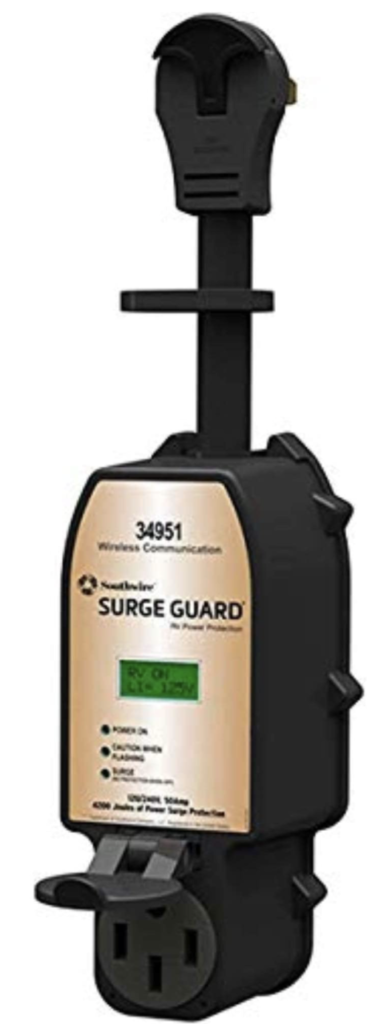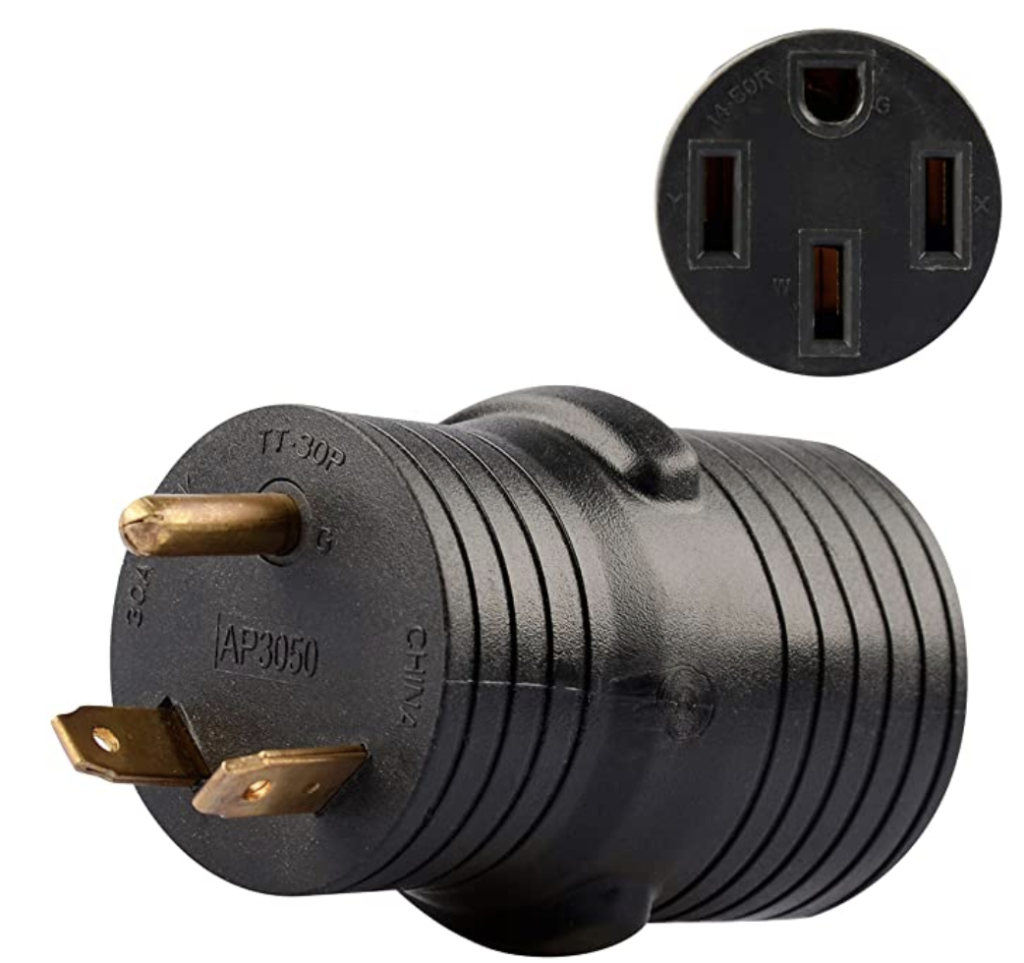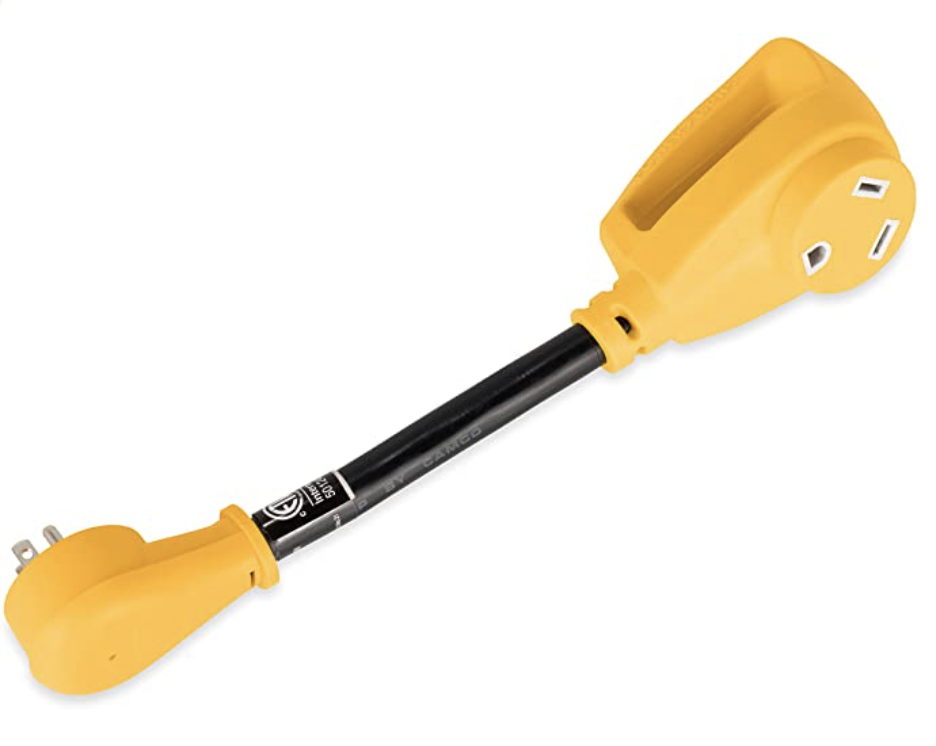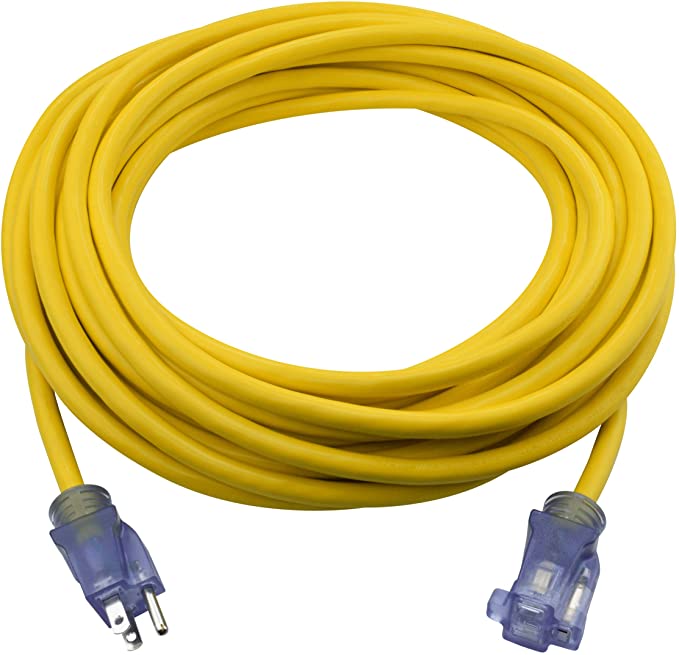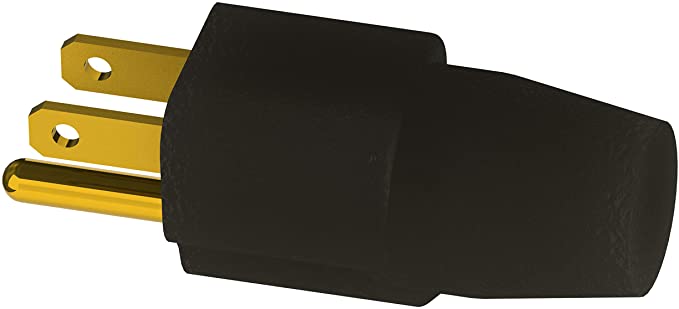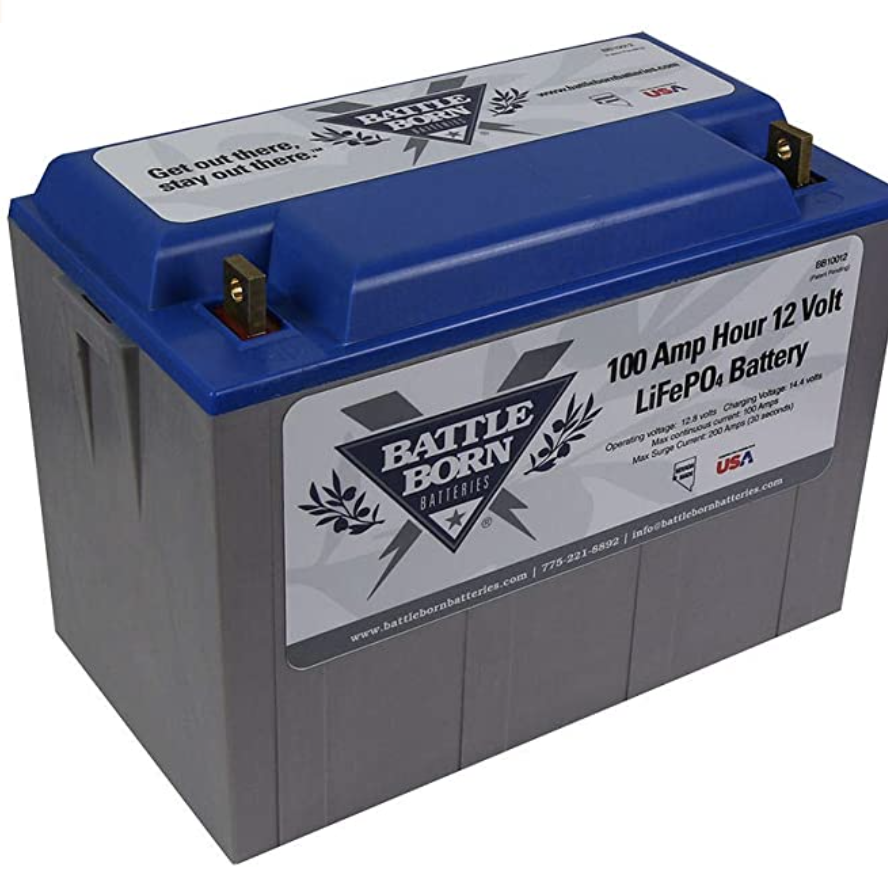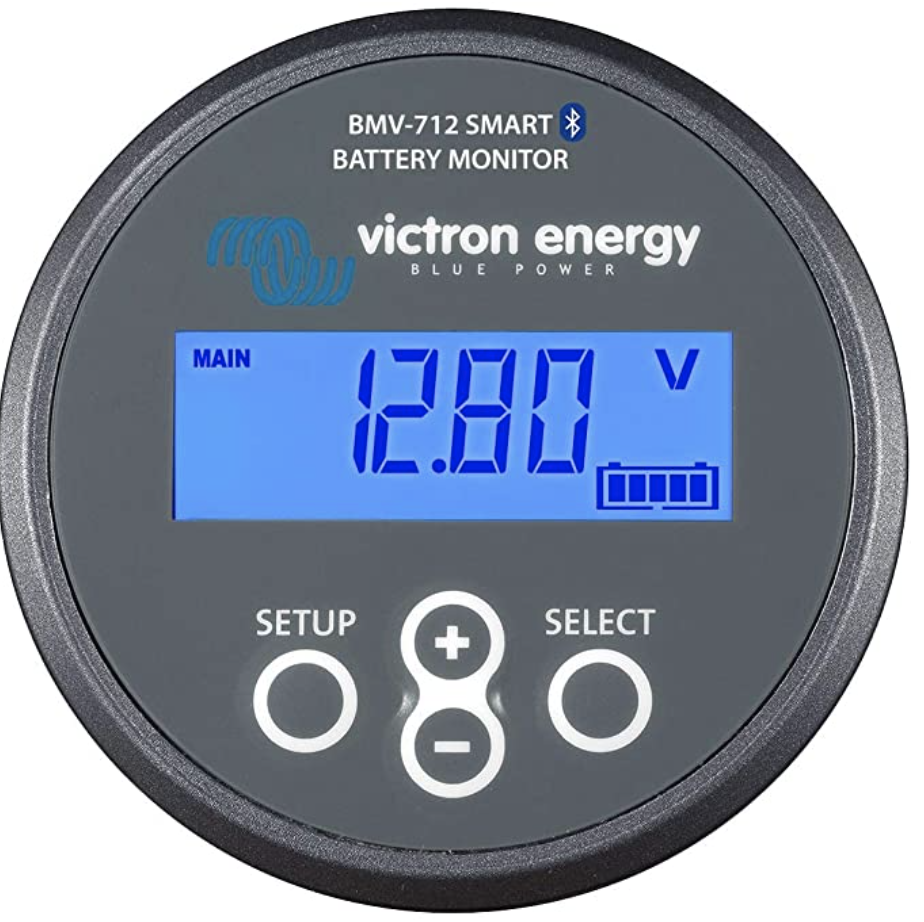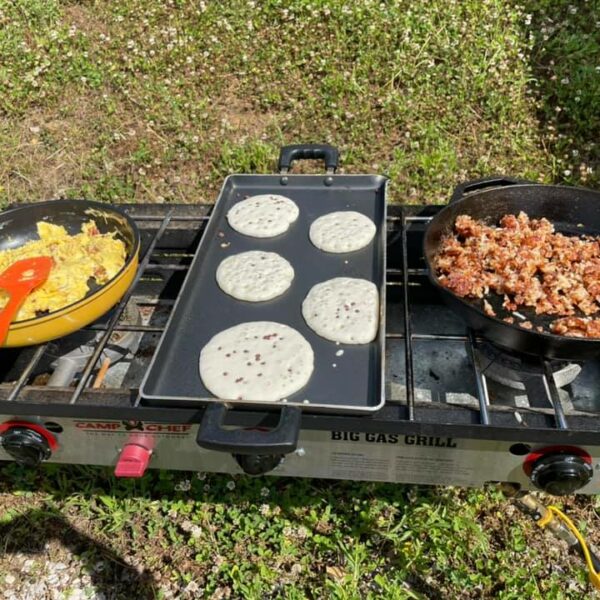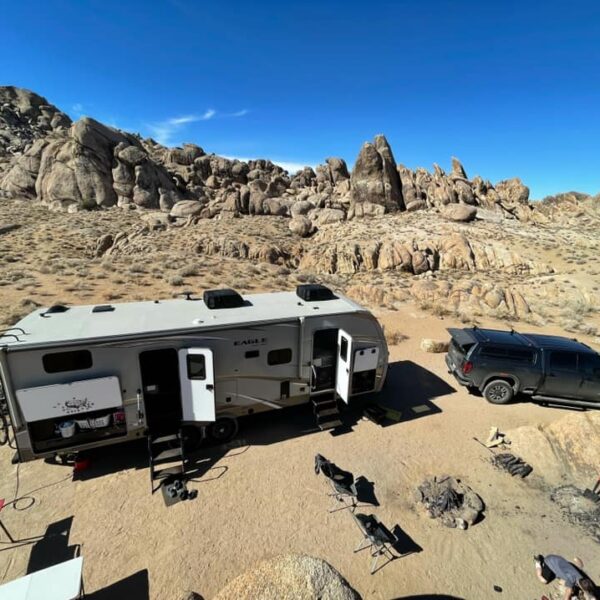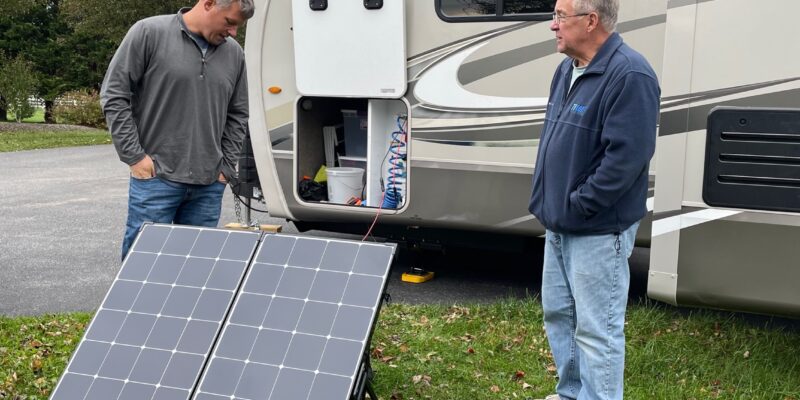
This is a big topic we will just touch on with this shopping list. We have a 50 amp camper. If you only have a 30 amp camper you will have slightly different needs, but you’ll want to explore similar options. Not everyone has the same power needs while camping. Some are more off-grid and minimize their draw while others off-grid would still like everything to work as if they had shore power connected. Many RVers want full hook-ups anywhere they go and consume more power, or simply never camp anywhere that would require the use of solar panels or a generator.
We typically stay at campsites with 50 amp hookups (or 30 amp minimum if we don’t have to run both A/C units). From time to time, we stop for a few nights at a campground without hookups, BLM Land, or a Harvest Host site. For these occasions, we want to ensure we have enough power to be comfortable, so we invested in solar panels and a gas-powered generator.
The opposite of not having power is also a common problem. Campgrounds are known for having power surge issues, or an inconsistent supply of it. Sometimes power boxes are faulty or not wired correctly. This is more common at older establishments, but in order to protect all of the electronics on-board, a surge protector is recommended. A higher-end surge protector can test for proper power and prevent any electricity from going to your camper if the tests don’t pass.
The point of a surge protector device is to trip and need to be reset for small issues or completely blow for larger ones. While burning up an expensive surge protector to a power issue at a campground can be angering and inconvenient, the sacrificial nature of the surge protector will have saved everything inside the camper from the same fate. We always use our surge protector, even when parked in our own driveway at home, since you never know when you’ll need it. Do we really need it plugged in at home, no… not really, but it is it a bit safer to be cautious. The main reason we use the surge protector at home is that we prefer to treat our setup as habit. We always use it, period. Thats the best policy to ensure you never bypass it and pay the price. This article contains affiliate links.
Having a surge protector that matches your camper is essential. There are many to choose from, but we use this 50 amp surge protector at every campground. If we are only at a 30 amp site, we have an adaptor, but we have found several campgrounds to have questionable electric set ups, and this has protected us. If you plug in the surge guard first, it’ll tell you whether there’s appropriate protection before you plug in the power to the RV. Read the directions that come with your surge protector. In general, you plug them in first, without connecting your camper’s power cable to it. Once all checks pass on your surge protector, you can connect your camper’s power cable to the surge protector.
As part of our routine set up, we lock our surge protector to the electric box. We have never had a problem, but we have been told they are high in value easy to take, so we don’t make it an easy target.
The Surge Guard unit we bought also has a wireless LCD display that can be bought and installed inside your camper. It’s a minor convenience, but it does allow you to check the values from the surge protector without exiting your camper (nice in foul weather or at night). Not a necessity, but it has been handy in a few cases.
We have an adaptor like this for when we are only using a 30 amp hookup. We still plug our 50 amp surge protector into the adaptor, and the adaptor goes into the 30 amp outlet at the box. The surge protector still works, and we get proper hookups. The only thing on our camper that makes us require 50amps is the draw from running two AC units at the same time. If we only run one AC unit with the rest of the on-board electronics, we stay safely within the 30amp limit.
We also have a dog-bone style adapter for converting 30 amp to 15 amp connection. We do not typically use this on the road, but we use this when we are parked in our driveway and getting electricity from our house. This adapter is great for what is commonly called mooch-docking, where you get power from your standard home hookup, or a friend’s. Its not dry-docking or boon-docking, as you will have some power, just not usually enough to run your entire camper.
For this setup, we start with a heavy-duty extension cord connected at the house, then connect to this dog-bone adapter (converting from a 15/20 amp connection to a 30 amp connection), then to the inline 30 to 50 amp adaptor, then to the 50 amp surge protector, and finally our heavy 50 amp cable to the RV power connection.
A heavy duty extension cord that can easily handle 15 amps is great to keep with your camper. It can be used when hooking up to shore power, when you don’t have access to a 30/50 amp circuit. We also found it useful in our regular site setup. When we were camping in the summer it was nice to be able to place a fan further from our camper. It was needed more often when we were winter camping all over the country and needed to use our heated water hose to prevent freezing pipes. The way we used our heated hose often left us with a long distance to run back to the power pole. Sometimes our campsite didn’t even have the common extra 15 amp circuit that many include. In those cases we used the extension core to run under our camper and plugged it into its outdoor receptacle. We prefer the extension cord with the lit end, not only is it easy to find in the dark but it is easier to know that the breaker that powers the cord is on. When it is lit, the cord is hot.
We chose an inverter generator because they run more quietly than most, they offer pure sine wave output, which is important for your small electronic devices, and many places have rules restricting the only generator use to this type (mostly due to noise).
We didn’t expect to use it often, but when boondocking for a couple days or to have for emergencies (like a campground losing power for an extended time), we wanted something we could rely on and wouldn’t be too disturbing. We run this on periodically and haven’t had any problems with it. I’m also happy to have this as a backup generator for emergencies at home.
There are many other brand (Honda comes to mind), that are far more expensive, and possibly more reliable. But, for us having a generator at all was a luxury and more just a stress relief knowing we had a backup power source in our truck bed. For that reason, we read many reviews and decide on the Predator 3500 from Harbor Freight as you couldn’t beat the price ( we also waited and watched the sales to purchase when they were running a $100 off sale, which seems somewhat frequent).
If you would like to still use your surge protector between your generator and your camper, you will need to properly ground your generator or us a grounding plug. Without it, our surge protect will fail to pass the check for a grounded connection and it will not allow power to flow to our camper.
We have a camper that is prepped for solar in two locations, The roof for a permanently mounted solution and a side port next to our water hookups for quickly attaching portable solar panels. We chose not to invest in the roof panels, and just went with a portable 200 Watt Solar Panel from Renogy (they sell smaller sizes too). This decision was partially for cost, but mainly from the perspective of being able to take the panels with us to our next camper (should we decide to move on to a different unit later in time). An added advantage of portability was use for other adventures, like more primitive camping, and boating.
You will also need an adapter from the solar panel MC-4 connectors to the SAE camper wiring (if camper is pre-wired). Prewired camper ports for permanent panels use the standard solar MC-4 connectors, but the ports for connecting portable panels use a small inline SAE connector. The Renogy solar panel we use comes with a build-in charge controller and has standard solar connectors. So, we needed this adapter to hook it up. This adapter also comes with what is known ad a polarity switcher/reverse (essentially is just swaps the male/female connecting point at your camper in case you end up with you ends that don’t go together, this will bridge that connection).
You may also want Solar extension wire with MC-4 connectors to place panels further from camper, to find good sunlight. Panels placed on the ground close to your camper are often shaded. It’s often overlooked that the sun doesn’t stay put and having a good length of extension wire should give you more options to adjust throughout the day. It’s worth noting that the electricity transfer is dependent on the length of the wire and the wire gauge. If you want a longer extension, you should increase the wire gauge. It’s a balancing act between length of extension and current from the panel to the battery.
Battery Upgrade to LiFePo (only if you are looking for more off-grid power). This is a big purchase upgrade and research should be done to determine if you want to make the upgrade. We swapped out our single Lead Acid battery for 2 BattleBorn LiFePo 100AH batteries. We are very happy with our decision and have had no trouble boondocking even while our buddy campers had drawn their battery banks dead.
Adding a Victron battery monitor was not a necessity, but it was a great decision. There is a mobile app for the device that operates with bluetooth. Not only do you get an amazing mount of data to explore on your phone, but you can check on it from anywhere within bluetooth range. The best part of having a device like this is being able to monitor your off-grid battery consumption. It can project your battery life based on usage. We found it great for isolating devices (turning only one thing on at a time) to figure out the draw of everything we commonly use. This helped us find the most power efficient lights to turn on in our camper at night. It even let us assess how much power we would lose if we wanted to watch our TV… yeah we would use it to see if we could handle a movie night with the kids at the end of a long day. There are other cheaper ways to gather the same information, but we didn’t find any as simple to use.
As an Amazon Associate, we earn from qualifying purchases. Many (but not all) of the links on embarkrv.com are affiliate links. This means that we may make a small commission on the sale of an item if you purchase through one of these links. The price of the item is the same for you whether it is an affiliate link or not, and using affiliate links helps us to maintain this website and bring you other great content. We have not been paid for our review of products. What we are recommending is based on our use and experiences while RVing.


